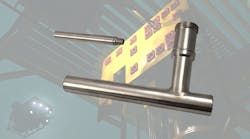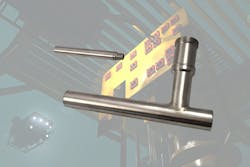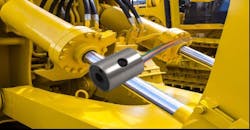Linear variable differential transformers (LVDTs) have been commercially used for more than 50 years. Originally developed as a laboratory instrument, LVDTs are now utilized in various industries such as computerized manufacturing, military, aerospace, subsea, oil and gas, power generation, packaging, robotics, and research and development for linear position measurement applications.
While advancements in manufacturing, electronic circuitry and construction materials have extended LVDT performance in a wider range of environments and applications over the years, the fundamental principles of its operation and key attributes such as dependability, toughness, sensitivity, accuracy, zero mechanical friction and long service life have remained unchanged. It is these trademark characteristics that have kept LVDTs relevant over the years and in demand by many industries.
READ MORE: Six Ways LVDTs Support Position Measurement in IoT Industrial Applications
What is an LVDT?
An LVDT is an electromechanical transducer that measures movements as small as ±0.010 in. (±0.254 mm) to ±10 in. (±254 mm) or longer in some cases. It converts linear motion into corresponding electric signals, which can be interpreted by operations and control systems.
In composition, LVDTs include two basic parts:
- A housing containing a single primary winding coupled to two secondary windings S1 and S2.
- A movable core mechanically linked to the measured object.
The housing and core rely on magnetic coupling and have no contact. Typically, the LVDT housing is fixed to a stationary reference point, and the measured object is mechanically linked to the movable LVDT core. As the core moves, the change in magnetic coupling between each secondary coil S1 and S2 produces an output proportional to the position of the measured part. The LVDT’s raw output can then be interpreted by a signal conditioner, which delivers an analog or digital output to a meter or logic controller. (See Figure 1)
Initially, LVDTs required external excitation from a signal conditioner to produce a digital output. However, modern LVDTs can now be built with internal signal conditioning modules, eliminating the need for external modulation, while still maintaining some beneficial characteristics of an AC-operated LVDT. AC units are still desirable in many applications with temperature extremes as they are not limited by the temperature limits of the internal electronics.
Why LVDTs Remain Popular
- LVDTs possess many traits that make them a “tried-and-true” technology for many applications.
- They are extremely rugged and durable. This has made LVDTs popular for decades in heavy industrial production applications such as paper mills as well as power generation stations.
- LVDTs are sensitive to very slight changes in position on the submicron level. Resolution is limited only by the signal conditioner. Precise feedback on infinitesimal movement is necessary for the optimal performance of different automated processes and measuring parameters for dimensional quality, TIR and thermal expansion.
- The frictionless operation of an LVDT provides for near-infinite mechanical life. They are reliable over millions of cycles, which is critical for installations with inaccessible or unattended locations, or when replacing equipment or instrumentation is expensive and cumbersome. They also eliminate the threat of stiction errors with stationary surfaces.
- LVDTs are sometimes the only type of position sensor that works for a given application. For example, LVDTs are preferred in harsh environments like underwater and space and other areas with extreme environments. The absence of onboard electronics in AC-operated versions can tolerate high levels of moisture, chemicals, shock, vibration and extreme temperatures without affecting performance or life.
Modern LVDTs
LVDTs have been updated to make them more energy efficient, compatible with control systems and easier to fit into tight installations while offering greater performance characteristics.
Higher pressures. The use of high-strength alloys now allows LVDTs to be hermetically sealed to pressures of 20,000 psi, making them suitable deep subsea environments, downhole use near cutting tools for oil exploration and other extreme high-pressure applications such as pressure test vessels and hydraulic actuators. They serve as ideal replacements for load cells, pots and magnetostrictive sensors in underwater use. (See Figure 2)
Higher temperatures. New higher-temperature materials and ceramics enable LVDTs to operate at temperatures exceeding 1,000°F, making them suitable for applications with rugged environments such as power plants, engine control systems and autoclaves.
Radiation resistance. When LVDTs are now constructed using radiation-tolerant and hardened materials so they can operate in nuclear power plants, aircraft, submarines and other applications with radiation exposure. (See Figure 3)
Greater reliability. LVDTs can be constructed with special alloys such as Monel, Inconel, Hastelloy and Titanium to extend their reliability when operating in challenging environments like seawater, corrosive acids as well as high/low temperatures and pressures.
Exotic alloys such as those that contain cobalt, nickel and chromium can deliver even higher performance from LVDTs where comparable technologies will not survive. For instance, a higher content of nickel, chromium and molybdenum extends chemical resistance to seawater in depths to 10,000 ft and external pressures of ~5000 psi.
LVDT construction materials are chosen based on parameters such as corrosion, pressure, and magnetic properties across the operating temperature range.
READ MORE: New Uses for Linear Variable Differential Transformers (LVDTs)
Convenient DC and digital outputs. PCBs with microelectronic processors allow for custom analog voltage, current and digital outputs directly from an LVDT or a remote-mounted signal conditioner. Digital outputs are critical for monitoring different assets in factory automation, especially as the industry moves to the IoT, smart factories and intelligent automation.
DC and digital outputs also offer convenience and higher reliability for laboratories to immediate process results with different third-party software. It also enables data to be saved in the clouds or shared with different partners.
Low power consumption. Modern LVDTs operate on lower voltages at 2.5 kHz – 10 kHz, making them resistive to noise created by electrical equipment and radio frequencies. They also consume much less power than legacy LVDTs that run on 120 V and 60 Hz that draw a lot of current. The lessened power consumption is critical in structural monitoring applications where measurements are made infrequently and paired with battery-powered electronics.
Smaller units. Computer-controlled winding machines allow for new coil designs previously not practical when LVDTs were wound by hand. This means LVDTs can be made smaller and lighter than ever before. Smaller, lighter LVDTs are of particular importance for spacecraft, robotics and where space is at a premium.
Vented. LVDTs can be designed with vented holes in the housing to equalize pressure inside and outside the unit to withstand a combination of high pressure, temperature, shock and vibration. Vented LVDT position sensors are ideal for high response dynamic measurement such as plastic injection molding machines, automatic inspection equipment as well as different robotic applications requiring displacement feedback to ensure proper machinery operation. (See Figure 4)
While LVDTs may have been around for a long time, many characteristics and operating benefits are just as relevant now as they were 50 years ago. The optimization of LVDTs with new performance and physical characteristics addresses even more modern applications, making them a cost-effective and more reliable choice than other sensor technologies on the market today.




